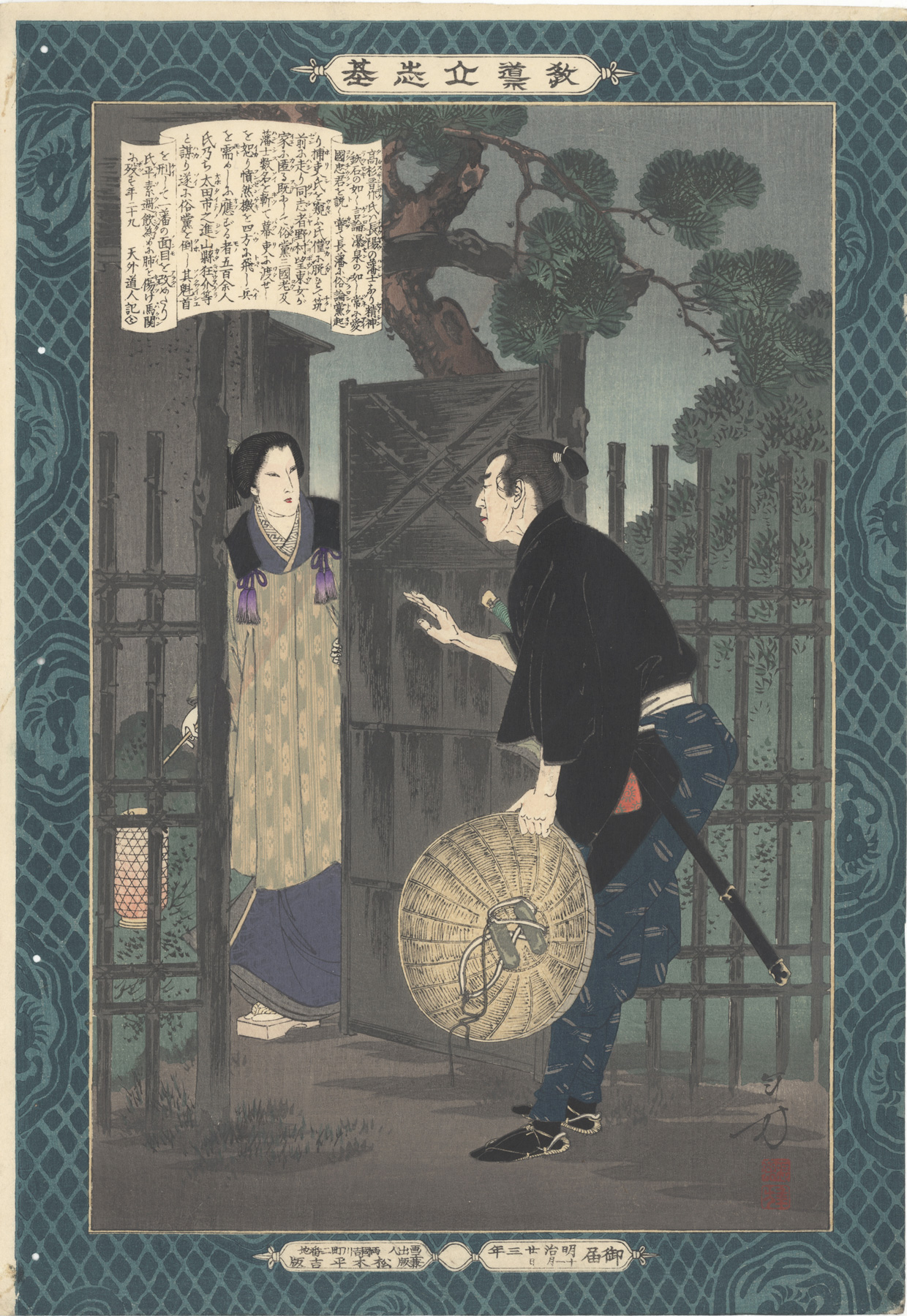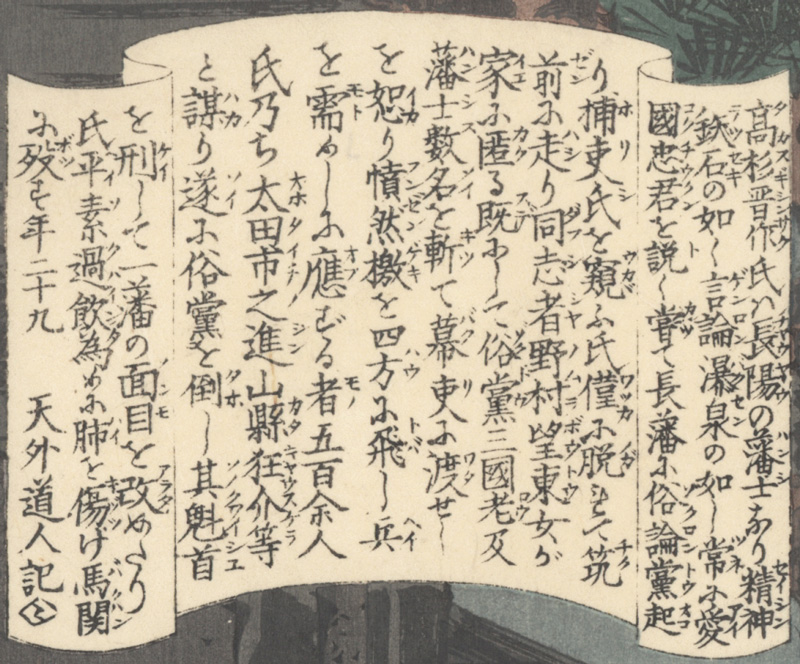About This Print
This unnumbered print1 in the series Instructive Models of Lofty Ambition depicts the arrival in February 1864 of the exiled Chōshū rebel, and later hero of the Meiji Revolution, Takasugi Shinsaku 高杉晋作 (September 1839–May 1867), at the home of the rebel sympathizer, the poetess Nomura Bōtō.2 For aiding Takasugi, Nomura would herself be sent into exile by the bakufu.1 Numbering of the prints was haphazard during the production of the series. While this print is unnumbered, the title for this print is shown in the 48th position listed in the Table of Contents for this series (reference Table of Contents from the series Instructive Models of Lofty Ambition). Print numbers were sometimes inadvertently omitted; some prints in the series were never assigned numbers and a few of the same numbers appear on different prints.
A Brief Outline of the Life of Takasugi Shinsaku
Sources: "Yōkyoku ni arawareta rinri shisō (Japanese Ethical Thought in the Noh Plays of the Muromachi Period)", Watsuji Tetsuro, translated by David A Dilworth, appearing in Monumenta Nipponica, Vol. 24, No. 4 (1969), p. 467-498.
Takasugi, son of a middle-ranking samurai of the Chōshū domain, was hero ofthe Meiji Restoration. He became aleader of the rebel faction in Chōshū which wanted to strengthen Chōshū’smilitary to keep the Western imperialists, who were dividing China into zones ofinfluence, at bay. His ideas coincided withthe growing Sonnō Jōi movement whose stated goal was to “expelthe barbarians and revere the Emperor.”
Standing against the rebel faction in Chōshū was a group of conservativeswho favored the bakufu. Power wouldshift between these two groups over the months and in February 1864, with theconservatives in ascendancy, Takasugi was forced to go into exile in Kyūshūto avoid imprisonment. Fleeing his home in Hagi, he traveled to Shimonoseki,from where he crossed over to Fukuoka under the alias Tani Umenosuke. At Fukuoka he hid at the home of the widowedpoetess and rebel sympathizer Nomura Bōtō 野村望東 (1806-1867). For her actions, Nomura would be sent into exile by the bakufu.
Eventually, the Chōshū conservatives who had pledged their support to the shogunate in Edo were defeated by therebels and Takasugi would begin military action against the bakufu, which would end with the defeatof the shogunate and the restoration of the Emperor to power – the MeijiRestoration. Unfortunately, Takasugi would not live to see the beginning of the Meiji Era in June 1868, dying of tuberculosis at the age of 28 on May 17, 1868.
About The Series "Kyōdō risshi no motoi"
Notes:1. This series is variously translated as "Instructive Models of Lofty Ambition," "Foundations of Learning and Achievement," "Foundation of Instruction and Perseverance," "Self-Made Men Worthy of Emulation," "Paragons of Instruction and Success," "Moral of Success," "Examples of Self-Made Leaders," and "Instruction in the Fundamentals of Success." The title in Japanese is sometimes seen as "Kyōdō risshiki or "Kyōdō risshi no moto," in addition to the most commonly seen transliteration of "Kyōdō risshi no motoi".2. For a complete listing of all the prints in the series and additional information please see the article on this site titled Instructive Models of Lofty Ambition.
This series ran between October 1885 and November 1890 and featured a long list of heroes and heroines, from antiquity to contemporary times, who were regarded as standards of moral leadership and self-realization.
This series ran between October 1885 and November 1890 and featured a long list of heroes and heroines, from antiquity to contemporary times, who were regarded as standards of moral leadership and self-realization.
Source: Kiyochika Artist of Meiji Japan, Henry D. Smith II, Santa Barbara Museum of Art, 1988, p. 74-75; original research and as footnoted.
This series of 58 prints,1 plus a table of contents sheet (目録), were originally published between October 1885 and November 1890 by the Tokyo publisher Matsuki Heikichi 松木平吉.2 The table of contents sheet issued by the publisher states that "fifty prints make up the complete set (五十番揃)". Three prints not in the initial release were added over the five year publication period, as were five redesigns of original prints, eventually increasing the total print count to 58. The seven artists contributing prints were Kobayashi Kiyochika (1847-1915) [20 prints], Mizuno Toshikata (1866-1908) [16 prints], Inoue Tankei (Yasuji) (1864-1889) [13 prints], Taiso (Tsukioka) Yoshitoshi (1839-1892) [5 prints], Yōshū Chikanobu (1838-1912) [2 prints], Toyohara Kunichika (1835–1900) [1 print], and Hachisuka (Utagawa) Kuniaki II (1835-1888) [1 print]. All the artists, with the exception of Yōshū Chikanobu, are listed in the top scroll of the table of contents sheet. Various colors (including blue, blue/green, and tan/brown) were used for the decorative border, and in 1902 the series was re-issued by Matsuki without borders.
Brief texts contained within a scroll-like cartouche appearing on each print provide historical details. The scroll composer's name is given at the end of the scroll text. The “lofty ambition” of the title is a Confucian concept, originally from Mencius, meaning “righteous determination that would inspire others.” The market for the series probably included former samurai, ambitious youth, and conservative intellectuals.
"[W]hen it was completed in 1890 the publisher was singled out for special recognition by the government for having sponsored such noble subject matter."3
This series of 58 prints,1 plus a table of contents sheet (目録), were originally published between October 1885 and November 1890 by the Tokyo publisher Matsuki Heikichi 松木平吉.2 The table of contents sheet issued by the publisher states that "fifty prints make up the complete set (五十番揃)". Three prints not in the initial release were added over the five year publication period, as were five redesigns of original prints, eventually increasing the total print count to 58. The seven artists contributing prints were Kobayashi Kiyochika (1847-1915) [20 prints], Mizuno Toshikata (1866-1908) [16 prints], Inoue Tankei (Yasuji) (1864-1889) [13 prints], Taiso (Tsukioka) Yoshitoshi (1839-1892) [5 prints], Yōshū Chikanobu (1838-1912) [2 prints], Toyohara Kunichika (1835–1900) [1 print], and Hachisuka (Utagawa) Kuniaki II (1835-1888) [1 print]. All the artists, with the exception of Yōshū Chikanobu, are listed in the top scroll of the table of contents sheet. Various colors (including blue, blue/green, and tan/brown) were used for the decorative border, and in 1902 the series was re-issued by Matsuki without borders.
Brief texts contained within a scroll-like cartouche appearing on each print provide historical details. The scroll composer's name is given at the end of the scroll text. The “lofty ambition” of the title is a Confucian concept, originally from Mencius, meaning “righteous determination that would inspire others.” The market for the series probably included former samurai, ambitious youth, and conservative intellectuals.
"[W]hen it was completed in 1890 the publisher was singled out for special recognition by the government for having sponsored such noble subject matter."3
1 The Tokyo Metropolitan Library online collection shows 50 prints and a Table of Contents sheet. The Table of Contents lists the titles of 50 prints. Smith in Kiyochika Artist of Meiji Japan identified 52 prints. I have identified 58 prints from this series including five prints (Ikina, Michizane Sugiwara, Kesa Gozen, Soga Brothers and Hokiichi Hanawa) that were re-designed and re-printed, likely due to damaged or lost blocks.
2 Robert Schaap notes in Appendix II, p. 166 of Yoshitoshi, Masterpieces from the Ed Freis Collection, Chris Uhlenbeck and Amy Reigle Newland, Hotei Publishing, 2011 that the series originally appeared as newspaper supplements.
3 The World of the Meiji Print: Impressions of a New Civilization, Julia Meech-Pekarik, Weatherhill, 1986, p. 122.
1 The Tokyo Metropolitan Library online collection shows 50 prints and a Table of Contents sheet. The Table of Contents lists the titles of 50 prints. Smith in Kiyochika Artist of Meiji Japan identified 52 prints. I have identified 58 prints from this series including five prints (Ikina, Michizane Sugiwara, Kesa Gozen, Soga Brothers and Hokiichi Hanawa) that were re-designed and re-printed, likely due to damaged or lost blocks.
2 Robert Schaap notes in Appendix II, p. 166 of Yoshitoshi, Masterpieces from the Ed Freis Collection, Chris Uhlenbeck and Amy Reigle Newland, Hotei Publishing, 2011 that the series originally appeared as newspaper supplements.
3 The World of the Meiji Print: Impressions of a New Civilization, Julia Meech-Pekarik, Weatherhill, 1986, p. 122.
Print Details
IHL Catalog
#1399 Title or Description Takasugi Shinsaku 高杉晋作 Series “Instructive Models of Lofty Ambition” (Kyodo risshiki 教導立志基) [note: series title also listed as 'Kyodo Risshi no Moto', ‘Kyodo risshi no motoi’, ‘Kyōdō risshi ki’ and variously translated as “Moral of success” or “Foundations of learning and achievement” or “Self-made Men Worthy of Emulation”' or “Examples of Self-made Leaders” or "Paragons of instruction and success"] Artist Mizuno Toshikata (1866-1908)
Signature  年方 Toshikata
年方 Toshikata
Seal of the artist 応斎 年方 sealed Ōsai and Toshikata as shown above Publication Date December 1890 明治廿三年 十一月 Publisher Matsuki Heikichi (松木平吉) proprietor of Daikokuya Heikichi [Marks: seal not shown; pub. ref. 029]
(from right to left)publishing and printing date: 御届 明治廿三年 十一月 日[notification delivered, Meiji 23rd year 11th month]
assigned number within series: blankpublisher information: 画工兼 出版人 両国吉川町二番地 松木平吉 版[artist and publisher Ryōgoku Yoshikawachō 2-banchi Matsuki Heikichi han] Impression excellent
Colors excellent Condition good - almost full-size; minor marks; five small binding holes along left edge
Genre ukiyo-e; rishki-e; kyōiku nishiki-e Miscellaneous position 44 in the Table of Contents for the series Format vertical oban
H x W Paper
14 1/2 x 10 in. (36.8 x 25.4 cm)
H x W Image
14 5/16 x 9 3/4 in. (36.4 x 24.8 cm)
12 1/2 x 8 1/8 in. (31.8 x 20.6 cm) area inside brocade border Literature Collections This Print
Tokyo Metropolitan Library 280-K24; Tokyo Digital Museum (Edo-Tokyo Museum) 96200405
| IHL Catalog | #1399 |
| Title or Description | Takasugi Shinsaku 高杉晋作 |
| Series | “Instructive Models of Lofty Ambition” (Kyodo risshiki 教導立志基) [note: series title also listed as 'Kyodo Risshi no Moto', ‘Kyodo risshi no motoi’, ‘Kyōdō risshi ki’ and variously translated as “Moral of success” or “Foundations of learning and achievement” or “Self-made Men Worthy of Emulation”' or “Examples of Self-made Leaders” or "Paragons of instruction and success"] |
| Artist | Mizuno Toshikata (1866-1908) |
| Signature |  |
| Seal of the artist | 応斎 年方 sealed Ōsai and Toshikata as shown above |
| Publication Date | December 1890 明治廿三年 十一月 |
| Publisher | Matsuki Heikichi (松木平吉) proprietor of Daikokuya Heikichi [Marks: seal not shown; pub. ref. 029] (from right to left) publishing and printing date: 御届 明治廿三年 十一月 日 [notification delivered, Meiji 23rd year 11th month] assigned number within series: blank publisher information: 画工兼 出版人 両国吉川町二番地 松木平吉 版 [artist and publisher Ryōgoku Yoshikawachō 2-banchi Matsuki Heikichi han] |
| Impression | excellent |
| Colors | excellent |
| Condition | good - almost full-size; minor marks; five small binding holes along left edge |
| Genre | ukiyo-e; rishki-e; kyōiku nishiki-e |
| Miscellaneous | position 44 in the Table of Contents for the series |
| Format | vertical oban |
| H x W Paper | 14 1/2 x 10 in. (36.8 x 25.4 cm) |
| H x W Image | 14 5/16 x 9 3/4 in. (36.4 x 24.8 cm) 12 1/2 x 8 1/8 in. (31.8 x 20.6 cm) area inside brocade border |
| Literature | |
| Collections This Print | Tokyo Metropolitan Library 280-K24; Tokyo Digital Museum (Edo-Tokyo Museum) 96200405 |



